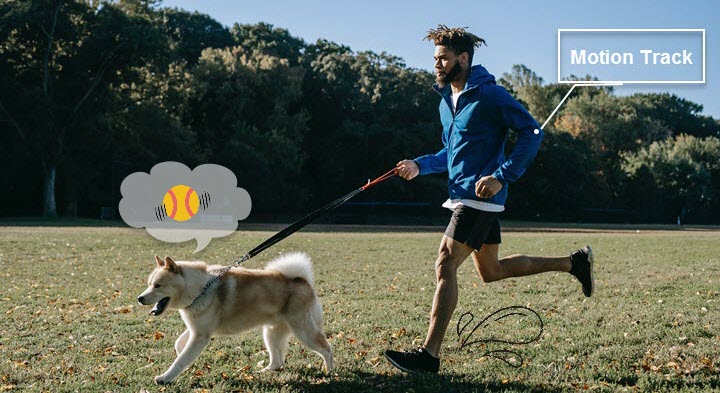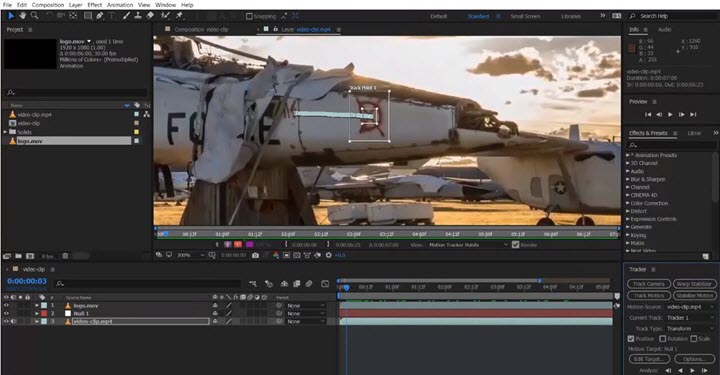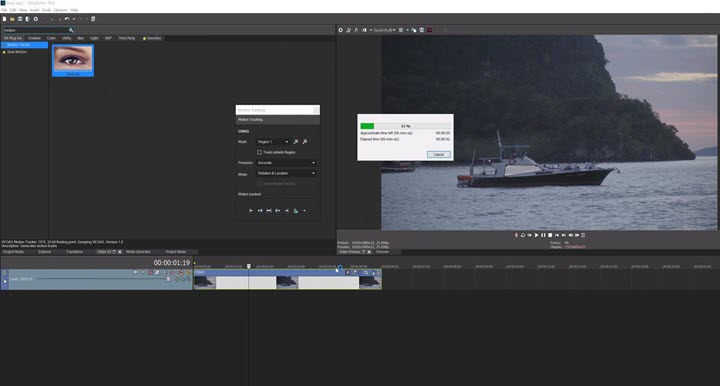In video editing, motion tracking is the process of tracking the trajectory of a moving object in the footage. The tracking data is later applied to other visual elements so that they can move together. This technique is used in many cases if you want to level up your video.
Technically, software with motion tracking features enables you to do these creative edits but differs in tracking precision, ease of use, price, and other editing capabilities. Taking these factors into account, we finally figure out the 10 best motion software. Here's a quick navigation:
- Open Source Motion Tracking Software: Kdenlive | Blender
- Motion Tracking Software with Free Version: HitFilm Express | VSDC | Filmora
- Advanced Motion Tracking Software: Davinci Resolve | Adobe After Effects| Sony VEGAS Pro
- Professional Software with Motion Tracking Plugins: Adobe Premiere Pro | Final Cut Pro
What Is Motion Tracking

Motion tracking in video editing is a technique used to follow the movement of an object or element within a video. It involves identifying a specific object or area within a video frame and then tracking its movement throughout the video. This can be used for various purposes such as adding visual effects, text, or graphics that follow the movement of the tracked object. Motion tracking is a valuable tool in video editing as it allows for the seamless integration of additional elements into a video, such as:
- Motion blur on faces or other objects.
- Attach texts/graphics to a person.
- Replace a phone screen or a billboard in dynamic shots.
- Apply color grading partially.
- Stabilize shaky footage.
- Create VFX (3D camera tracking).
10 Best Motion Tracking Software
1. Kdenlive
Platform: Windows, Mac, Linux, FreeBSD, Ubuntu
Version: Kdenlive 20.04 and later
Price: Free
Kdenlive is an open source and free video editing program that recently packed a motion tracker into its Effects option. This tool analyzes the tracking data of an object designated by you and maps out its moving track automatically. Then with this track, you can add motion effects, align a title, an image, an icon, and any 2D elements to the moving object. As one of its main features, the algorithms of Motion Tracker have been updated constantly, which results in a higher tracking success rate and faster tracking speed.
Pros:
- Free and safe to download and use.
- Accurate motion tracking analysis.
- Flexible tracking methods: cover and offset.
- Full editing features: speed ramping, color grading, advanced effects, etc.
Cons:
- Semi-automatic.
- Cannot be used for stabilization.
- Can't do 3D motion tracking.
2. Blender
Platform: Windows, macOS, Linux
Version: Blender 2.79 and later (auto-tracking)
Price: Free
Another open source and free motion tracking app on our list is Blender, a great VFX video editing software. It's the leading software that developed motion tracker a long time ago, but the automatic motion tracking add-on was created in 2.79.
Blender is capable of both 2D motion tracking and camera tracking. After fetching some tracking points of the elements in a video, Blender empowers you to add 2D texts or icons to the selected element, remove shakiness, bumps, and jerks from the footage, and build a 3D scene based on tracking markers so to add 3D objects to the scene.
Pros:
- Robust and advanced camera reconstruction.
- Real-time preview of the video and a 3D scene for precise composition.
- Motion tracking, 3D composition, and video editing in one-stop.
Cons:
- Complicated interface and workflow.
- Extreme steep learning curve.
- Slow rendering and encoding.
3. HitFilm Express
Platform: Windows and Mac OS X (64-bit only)
Version: HitFilm Express 12 and later
Price: Free
If you are learning basic 2D motion tracking, the free version of HitFilm Express is a good place to start. It has two types of motion tracking to get better tracking results – Single Point for tracking the position only and Double Points for tracking the position, the scale, or the rotation of an object. With the tracking data, it enables you to either stabilize the footage or transform the point with a CG object.
The remarkable tracking method in it is Optical flow. By determining the flow of brightness of the moving object, it successfully tracks a moving object that changes into different shapes or is obscured for a few frames. So, beginners can save much time and energy customizing options to deal with complicated frames.
Pros:
- Friendly to beginners.
- Full basic VFX compositing features in its free version.
Cons:
- Watermarks on unpurchased effects.
- High CPU usage to drag down the performance.
- Only recent versions support HEVC/H.265 videos.
4. VSDC
Platform: Windows
Version: VSDC 6.4.2 and later
Price: Free
The motion tracking feature in VSDC is much simpler to use for fewer options and parameters to cope with. You just need to select the area to follow up, then VSDC analyzes its trajectory which will be saved as a movement map afterward, and apply the track to another object you added in a new layer, such as, filters, masks, titles, images, animations, and other elements in free shapes. But if the object moves very fast or disappears for a few frames, it will fail to analyze or map out an inaccurate path.
Pros:
- Automatic and quick motion tracking.
- Free with no watermark nor time limits.
- Movement maps can be used on other PCs.
Cons:
- Detection stops when the object gets covered by others.
- Unviable for macOS.
5. Filmora
Platform: Windows, Mac
Version: Filmora X and later
Price: Free with watermarks; $61.99/yr for full features
Compared to the rest, Filmora is the easiest motion tracking software. It hides all the intimidating parameters that you have to learn in other apps and calculates them behind the scene automatically. With the tracking data, you can add visual elements from its preset folder or your computer to it. It also adds the mosaic effect to this option, so you can quickly blur the face in your video.

Pros:
- Simple, automatic, and intuitive.
- Precise track on objects with distinct edges or colors.
- A bunch of preset texts, titles, and mosaic to add.
Cons:
- You cannot export the video without an account.
- Video will be watermarked in the free version.
- Cannot tweak the tracking results if it's not ideal.
- Cumbersome to track multiple moving objects in one clip.
6. Davinci Resolve
Platform: Windows, macOS, Linux
Version: Davinci Resolve 16, Davinci Resolve 17, Davinci Resolve 18, and its free version
Price: $299
Davinci Resolve, the industrial-level video editing software, stands out for RAW editing, multi-cam editing, professional color grading, and also, motion tracking. It has two motion tracking modes – Point Tracker and Planar Tracker. With the former option, texts and titles you insert are similar to common overlay but move together with the object. While with the other, you can see these elements in different angles in an object that is tilting. And that's how a phone screen on someone's hand is replaced.
Pros:
- Free and fully featured.
- Full control over the motion tracking settings.
- Frame by frame tracking for the best outcome.
- Unique and quick face tracking.
Cons:
- Complicated interface and operations.
- Require high-end computers.
7. Adobe After Effects
Platform: Windows, macOS
Version: All recent versions
Price: $239.88/yr
It's time to switch from Premiere Pro to After Effects if you really want to level up your video. This powerful tool can track a sophisticated object successfully regardless of its varying shape/color or movements speed. Meanwhile, don't forget that After Effects is designed for VFX and motion graphics creation. So you can create almost everything you need to add to your source video, cinematic titles, animated texts, and 3D graphics. Besides, the tracking data it detects can be also used to stabilize the footage, mask faces, dynamic crop, etc.

Pros:
- A collection of advanced motion tracking methods.
- Accurate outcomes for varied needs.
- Collaborate with other creative software from Adobe.
Cons:
- The free trial ends soon.
- Many professional parameters to learn.
8. Sony VEGAS Pro
Platform: Windows 11/10
Version: VEGAS Pro 18 and above
Price: $399
Auto motion tracking is a newly updated feature in VEGAS Pro 18. It was born late but integrated the Academy Award winning Mocha masking and planar tracking system. It lets you attach pictures and texts precisely and even fit the changing perspective. With this feature, you can also obscure faces, license info, and any private objects.

Pros:
- Automatic and precise 2D motion tracking.
- Track multiple objects in one video.
- Better support for RED RAW, Blackmagic RAW, and Panasonic P2.
Cons:
- Too expensive and complicated for newbies.
- There aren't many video tutorials on this feature.
- Not available on Mac.
9. Final Cut Pro
Platform: macOS 10.15.6 or later
Version: Final Cut Pro 10.2 and later
Price: $299.99
In fact, Final Cut Pro cannot track the path of moving objects automatically per se. It is the plugins that extend its power to the maximum. For example, FCPX Auto Tracker from Pixel Film Studios, and mTracker3D from Motion VFX. Without plugins, you have to browse the video frame by frame and insert keyframes in terms of the moving path.
Pros:
- Automatic with third-party plugins.
- Perfect compatibility with 4K ProRes RAW and 8K.
Cons:
- Extra fees for auto motion track plugins.
10. Adobe Premiere Pro
Platform: Windows, macOS
Version: All recent versions
Price: $239.88/yr
Premiere Pro seems a must for anyone learning video editing for its excellent editing capabilities. But to give the maximum power to users, Premiere Pro does not have many presets and automatic tools. As for motion tracking, the auto option only works when masking and blurring a face. Otherwise, you need to add texts or resize the footage by inserting and adjusting numerous keyframes, or install an extension to convert the tracks of the mask to any transformed elements.
Pros:
- Advanced and professional video editing features.
- Automatic motion blur features.
- Co-work with other Adobe creative products.
Cons:
- Manual and tiring settings for tracking movements.
FAQs
What's the difference between motion tracking and camera tracking?
Camera tracking deals with the movement of the camera itself, while motion tracking focuses on the movement of specific elements within a scene. Both techniques are essential for creating seamless visual effects in film, television, and other media.
Does iMovie have motion tracking?
No, iMovie only offers some basic editing features. If you want to attach an icon to a moving object, you need to insert keyframes, and adjust its position in every keyframe.








